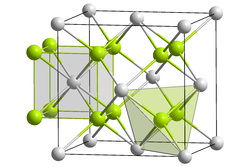 Crystal structure of potassium polonide __ K+ __ Po2- | |
| Names | |
|---|---|
| Preferred IUPAC name Potassium polonide | |
| Identifiers | |
3D model (JSmol) | |
| |
| |
| Properties | |
| K2Po | |
| Molar mass | 287.18 g/mol |
| Appearance | greyish [1] |
| Related compounds | |
Other anions | Potassium oxide Potassium sulfide Potassium selenide Potassium telluride |
Other cations | Lithium polonide Sodium polonide Rubidium polonide Caesium polonide |
Except where otherwise noted, data are given for materials in their standard state (at 25 °C [77 °F], 100 kPa). | |
Potassium polonide is a chemical compound with the formula K 2 Po. It is a polonide, a set of very chemically stable compounds of polonium. [2] [3]